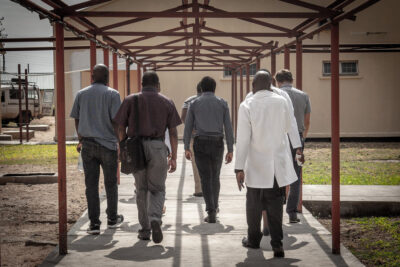Main content
In 2023, official statistics reported 164,487 live births in the Netherlands.[1] However, these figures exclude children whose parents are not listed in the Dutch Personal Records Database (BRP), such as undocumented migrants and recent asylum seekers. Without registration in the BRP, these individuals lack not only a social security number (BSN) and the associated access to essential services in the Netherlands, but also the fundamental right to be counted. This phenomenon, known as data invisibility, both conceals and perpetuates migration-related health inequities worldwide and in the Netherlands.[2,3]
Uncounted births
Data invisibility arises when marginalised migrant populations remain unaccounted for in research, public health monitoring, or national health and population statistics. This often affects those with a precarious legal status who may avoid healthcare, face restricted access, or whose health data are not retraceable. In the previous example of the Netherlands, asylum seekers are generally added to the BRP and receive a BSN after six months of residence (although this process has faced major delays in recent years), while undocumented individuals, such as asylum seekers whose applications have been rejected, are excluded from the BRP entirely.[4] When these unregistered parents have children, their newborns may receive a birth certificate from the municipality, but their births are not formally registered by Statistics Netherlands (CBS), which only counts official residents. Consequently, these children are omitted from official Dutch birth statistics, leaving their existence bureaucratically invisible.
Uncounted lives, uncounted deaths
Recent research demonstrates that data invisibility obscures not only the lives, but also the deaths of affected migrant populations. In a nationwide registry study, we aimed to examine perinatal mortality and other adverse pregnancy outcomes in asylum seekers and refugees with a residence permit (“forced migrants”) in the Netherlands.[5] Previous studies had revealed alarming findings, with one Dutch study reporting mortality rates up to seven times higher among asylum seekers at the Ter Apel reception centre compared to the general population.[6] In our registry-based study, we linked data from a migration database managed by CBS to the Dutch perinatal registry (Perined), creating a cohort of more than 16,000 births among forced migrants between 2014 and 2019.[7]
Our study confirmed elevated risks of adverse pregnancy outcomes, including perinatal mortality, among forced migrants compared to Dutch women without a migration background (relative risk 1.50 [95% CI 1.20-1.88]). However, as women without a BSN – those who recently arrived or were undocumented – could not be included for data linkage, their births were excluded from our study. As this subpopulation may be at the highest risk of adverse outcomes, this manifestation of data invisibility may explain why the differences found in our study were less extreme than those reported in Ter Apel.[6]
While data invisibility obscures, it also exacerbates the inequities that affect marginalised migrant populations, since alarming trends and urgent health needs are not reflected in research that can inform policy and resource allocation.[3] This issue was tragically illustrated by a maternal death that was reported to the authors only after the study had concluded that no maternal mortality had been registered in the study period. The case involved an asylum-seeking woman who had arrived late in her pregnancy and died before receiving a BSN.
Recommendations
The process of forced migration often inherently disrupts access to healthcare and the corresponding data collection. As highlighted by recent research, migration-related data across Europe is often fragmented, incomplete, and of poor quality, despite the available knowledge and technology to address this issue. Political factors at local, national, and European levels continue to hinder the systematic collection of migration-related health data.[3,8] However, to prevent data invisibility once people arrive in the Netherlands, a number of changes are possible and necessary, including:
- Every child born in the Netherlands must be counted in official statistics.
- Asylum seekers and undocumented migrants should be registered in the BRP and receive a BSN urgently, or an alternative identification number usable for data linkage must be expedited, especially for populations in potentially vulnerable health situations, like pregnant women.
- To disaggregate health data based on migration status, health information systems in hospitals, and databases such as the Dutch national perinatal registry (Perined) need to incorporate migration indicators such as country of birth, length of residence and legal status. Recent recommendations in the Lancet Regional Health also highlight the necessity and ethical use of such indicators to capture and monitor the health needs of different migrant groups.[3]
- Health data from actors involved in the migration sector, such as Gezondheidszorg Asielzoekers (GZA) in the Dutch asylum reception centres and non-governmental organisations such as Doctors of the World, should be as accessible as possible for research and monitoring purposes. The Ministry of Health needs to ensure that the quality of healthcare, data registration, and access are managed with the same standards and transparency applied across the broader Dutch healthcare system.
Conclusion
Addressing data invisibility is vital to reducing health inequities among migrant populations in the Netherlands. Failure to include undocumented and recent asylum-seeking populations in national health registries leaves the most disadvantaged groups unaccounted for, thereby perpetuating their marginalisation and obscuring the true extent of health inequities. To remedy this, equitable registration and the ethical use and integration of health and migration data are needed to create a more complete and accurate picture of the health needs of underserved populations. This strategy would also align with the mission of the Dutch Ministry of Health’s “Solid Start” (Kansrijke Start) programme to facilitate the best possible start of life for every child born in the Netherlands. Ultimately, achieving health equity depends on the right to be counted.
References
- Centraal Bureau voor de Statistiek (CBS). Geboorte; kerncijfers vruchtbaarheid, leeftijd moeder, regio. [Internet]. Available from: https://www.cbs.nl/nl-nl/cijfers/detail/37201. [Accessed 28 October 2024].
- Schoenborn C, De Spiegelaere M, Racape J. Measuring the invisible: perinatal health outcomes of unregistered women giving birth in Belgium, a population-based study. BMC pregnancy and childbirth. 2021;21(1):1-13.
- Bozorgmehr K, McKee M, Azzopardi-Muscat N, Bartovic J, Campos-Matos I, Gerganova T-I, et al. Integration of migrant and refugee data in health information systems in Europe: advancing evidence, policy and practice. The Lancet Regional Health-Europe. 2023;34.
- Personal Records Database (BRP): Dutch Government. [Internet]. Available from: https://www.government.nl/topics/personal-data/personal-records-database-brp.
- Tankink J.B., Bertens, L.C.M., De Graaf, J.P., Van den Muijsenbergh, M.E.T.C., Struijs, J.N., Goodarzi, B., Franx, A. Pregnancy outcomes of forced migrants in the Netherlands: a national registry-based study. Journal of Migration & Health. 2024.;10(100261).
- Verschuuren A, Postma I, Riksen Z, Nott R, Feijen-de Jong E, Stekelenburg J. Pregnancy outcomes in asylum seekers in the North of the Netherlands: a retrospective documentary analysis. BMC pregnancy and childbirth. 2020;20(1):1-10.
- Perined: The Netherlands Perinatal Registry. Available from: https://www.perined.nl/
- International Organization for Migration. Leave No Migrant Behind: The 2030 Agenda and Data Disaggregation. [Internet]. Available from: https://publications.iom.int/books/leave-no-migrant-behind-2030-agenda-and-data-disaggregation.



















































